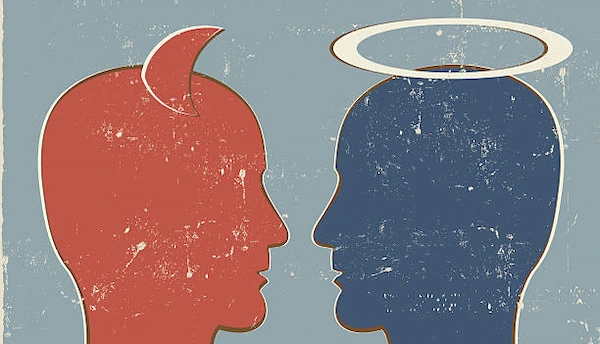
Throughout the tapestry of human history, war has been an enduring thread—not merely a consequence of territorial ambition or resource scarcity, but a manifestation of something far more fundamental to the human condition. At the core of many conflicts lies a profound psychological and spiritual dimension rooted in the duality of human consciousness. This exploration delves into how the mind’s tendency toward division creates the fertile ground from which conflict springs, examining how individuals become entrenched in oppositional identities that can ultimately lead societies toward destruction.
The Fractured Mirror: Understanding the Dual Mind
The human brain’s hemispheric division—left hemisphere governing logic and linear thinking, right hemisphere facilitating creativity and holistic perception—represents more than mere neuroanatomy. This physiological split mirrors a deeper psychological tendency that shapes our perception of reality itself. The divided brain creates a divided world, filtering existence through the lens of binary opposition.
This dualistic framework does more than simply categorize experience—it fundamentally alters how we perceive ourselves in relation to others. The mind, seeking order in complexity, creates boundaries where perhaps none naturally exist. These mental constructs become the invisible architecture of conflict, as arbitrary divisions take on the weight of absolute truth in human consciousness.
When we examine ancient philosophical traditions, we find remarkable consistency in identifying this dualistic tendency as a source of suffering. From the Taoist concept of yin and yang to the Hindu notion of maya (illusion), wisdom traditions across cultures recognized that perceiving reality through binary opposition creates a fundamental misapprehension of the interconnected nature of existence.
The Psychological Alchemy of Otherness
The transformation from mere difference to dangerous opposition follows predictable psychological patterns that have been observed across cultures and throughout history:
- Identity Formation Through Contrast: Human identity forms not in isolation but through differentiation. We understand who we are partly by understanding who we are not. This natural process becomes problematic when it calcifies into rigid boundaries between “us” and “them.”
- Cognitive Dissonance and Moral Licensing: When faced with information that contradicts our group loyalties, the discomfort of cognitive dissonance drives us to reject contradictory evidence rather than reconsider our position. This psychological mechanism allows groups to maintain moral self-image while engaging in increasingly immoral actions toward outgroups.
- Confirmation Bias and Echo Chambers: The mind’s tendency to seek evidence that confirms existing beliefs creates self-reinforcing information ecosystems where opposing perspectives are not merely dismissed but actively demonized. In these closed circuits of thought, extreme positions become normalized through repeated exposure.
- Social Identity and Existential Meaning: Henri Tajfel and John Turner’s Social Identity Theory reveals how group membership becomes intertwined with personal worth. When group identity provides existential meaning and purpose, perceived threats to the group can trigger defensive reactions that manifest as hostility, as they represent not merely political disagreement but existential danger.
- The Shadow Projection Phenomenon: Drawing from Jungian psychology, the tendency to project disowned aspects of ourselves onto others creates a particularly dangerous dynamic. The qualities we most despise in our enemies often represent disowned elements of our own nature—making reconciliation nearly impossible without profound self-awareness.
This psychological architecture creates a perfect storm for conflict escalation. Once these mechanisms take hold, opposing factions become trapped in a self-reinforcing cycle of mutual demonization, where each defensive action by one group confirms the worst fears of the other.
From Individual Psychology to Collective Madness
What makes these psychological tendencies particularly dangerous is their capacity to scale from individual cognition to collective movements. Historical analysis reveals how charismatic leaders throughout history have exploited these innate psychological vulnerabilities to mobilize populations toward conflict:
- Narrative Control: By crafting compelling stories of historical grievance, cultural superiority, or existential threat, leaders channel individual insecurities into collective action.
- Sacred Values and Moral Imperatives: When conflicts become framed in terms of sacred values rather than practical interests, compromise becomes morally unthinkable rather than merely undesirable.
- Dehumanization as Psychological Preparation: The gradual process of dehumanizing opponents removes natural empathic constraints against violence, reframing destruction as a form of purification or protection.
These mechanisms explain why rational appeals often fail to resolve deep-seated conflicts. When war becomes spiritualized—imbued with cosmic significance—practical considerations like material cost and human suffering become secondary to symbolic victory.
Transcending the Divided Mind: The Path Toward Unity Consciousness
In stark contrast to the fractured consciousness that fuels conflict stands the possibility of a fundamentally different mode of being—one recognized by contemplative traditions across cultures and increasingly validated by contemporary neuroscience.
The Neuroscience of Integration
Recent advances in neuroscience suggest that the rigid hemispheric specialization once accepted as fixed can be transcended through contemplative practices. Research on long-term meditators reveals increased corpus callosum density and enhanced interhemispheric communication—physiological evidence of integration between analytical and holistic processing.
This neuroplasticity suggests that the divided mind is not our inevitable condition but rather a developmental stage that can be transcended through conscious practice. The integration of dual processing creates the potential for a more comprehensive perception that holds paradox without needing to resolve it through opposition.
Principles of Unification
Several principles characterize the shift from dualistic to unitive consciousness:
- Radical Interconnectedness: Beyond mere intellectual acknowledgment, direct experiential recognition of interconnectedness transforms how we perceive boundaries between self and other. This shift from conceptual understanding to lived experience represents the core transformation described in contemplative traditions worldwide.
- Complementarity Instead of Opposition: Rather than perceiving differences as threats, unitive consciousness recognizes them as complementary aspects of a greater whole. This perspective allows holding multiple truths simultaneously without requiring elimination of apparent contradictions.
- Transcendence of Ego-Identification: Many spiritual traditions identify ego-bound consciousness—the sense of separate selfhood—as the root of suffering. As attachment to fixed identity loosens, so too does the psychological need for oppositional thinking that sustains conflict.
- Embracing Paradox: Mature spiritual consciousness develops the capacity to hold paradoxical truths simultaneously—recognizing both the relative reality of distinctions and their ultimate inseparability. This cognitive flexibility prevents the rigidity that leads to ideological extremism.
Practical Pathways to Transformation
Moving from theory to practice requires concrete approaches that can be implemented at both individual and societal levels:
- Contemplative Practice: Meditation, mindfulness, and other attentional training practices develop metacognitive awareness—the ability to observe one’s thought patterns rather than being unconsciously driven by them. This self-awareness creates the essential space between stimulus and response where choice becomes possible.
- Perspective-Taking Across Divides: Structured dialogue processes like those pioneered by conflict resolution specialists provide frameworks for encountering different worldviews without defensive reaction. These practices develop the cognitive empathy necessary for transcending the us/them mentality.
- Educational Approaches: Educational systems that integrate contemplative practices with critical thinking develop both the analytical skills to recognize manipulation and the emotional resilience to engage with difference constructively.
- Narrative Transformation: Collective healing requires transformation of narratives that perpetuate division. This involves acknowledging historical wounds while creating new stories that emphasize shared humanity and common destiny.
- Embodied Ethics: Beyond abstract principles, cultivating ethics grounded in embodied awareness of interconnection creates natural constraints against harm as empathy becomes a lived reality rather than an intellectual position.
Conclusion: Transcending the War Within
The path beyond war begins with recognizing that external conflicts reflect internal division. The fragmented consciousness that perceives reality through opposition must itself be healed before sustainable peace becomes possible. This healing represents not merely a political goal but an evolutionary imperative—the next stage in human development.
By understanding the spiritual and psychological roots of conflict, we gain access to more profound solutions than mere political negotiation can provide. The journey from division to unity represents humanity’s most essential task—one that begins within each individual consciousness but ultimately transforms our collective reality.
As we cultivate awareness of our tendencies toward dualistic thinking and develop the capacity for more integrated consciousness, we create the foundation for a world where differences enrich rather than threaten. This transformation represents not idealistic wishful thinking but the practical prerequisite for human survival in an increasingly interconnected world.
ARE YOU LIVING IMMERSED IN DUALITY?
From a philosophical standpoint, the concept of duality pertains to the notion of two fundamental and opposing principles that coexist. These principles may be exemplified by the dichotomy of the mind and the body, the antithesis of good and evil, or the opposition of reason and emotion. This binary opposition gives rise to questions concerning the nature of reality and existence, thereby prompting debates on whether these opposites are genuinely distinct entities or interconnected aspects of a unified whole. From a spiritual perspective, duality is often regarded as an illusion that diverts individuals from attaining oneness with the universe. Consequently, numerous spiritual schools of thought encourage transcending this dualistic mode of thinking in order to achieve enlightenment or heightened consciousness.
Read the statements below and select those that resonate with you.
Note the number of selected boxes and see the associated profile.
0: Duality doesn’t really belong to you
1-2: There is a little bit of Duality in you
3-4: You are heavily influenced by Duality
5-6: You are fully immersed in Duality
ARE YOU A TRUE PACIFIST?
Do peaceful humans really exist? Are those who call themselves “pacifists” really so? Or are they simply in love with the idea that they can get along with everyone? Given that wars and conflicts never cease, one might assume that true pacifists are actually a small minority!
Read the sentences below and select the ones you agree with and that you think make the most sense.
Determine the number of selected boxes and examine the resulting profile.
0: You are probably a true pacifist
1-2: You are a pacifist when it’s convenient
3-4: You are more warmonger than pacifist
5-6: You are a true warmonger
Further details on pacifist spirit





